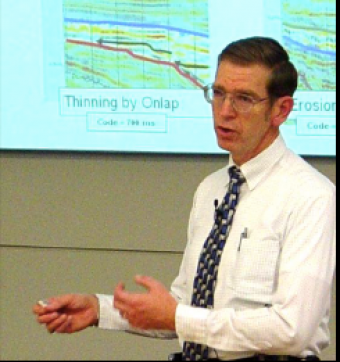Date: October 31, 2016 1h Advanced
With our geologic framework, we have mapped the significant horizons and faults, with special interest paid to depositional sequences (between sequence boundaries) that are potential reservoirs, sources, or seals. We want to know how thick depositional sequences are, the environments that they were deposted in (EODs), and the types of litholigies that they contain. Thickness maps provide information about the thickness (of course!), but can help us determine how EODs and lithologies vary across the area of interest.
Divide the class time into three (3) segments: the review of the previous exercise, the lecture material presented here, and introduce the exercise. The review of the exercise on Seismic Sequences has eleven (11) slides and takes ~25 minutes to explain. The lecture material contains sixteen (16) slides, and takes ~25 minutes to explain. The introduction to the exercise has six (6) slides, and takes ~10 minutes to explain.
At the end of this lesson, students should be able to:

This course, based on teaching material from Dr. Fred Schroeder (formerly of Exxon/ExxonMobil), reflects on the geology and geophysics basics for the petroleum industry. General geology and basic geophysics are not required, but helpful with the material.
We encourage the reuse and dissemination of the material on this site as long as attribution is retained. To this end the material on this site, unless otherwise noted, is offered under Creative Commons Attribution (CC BY 4.0) license